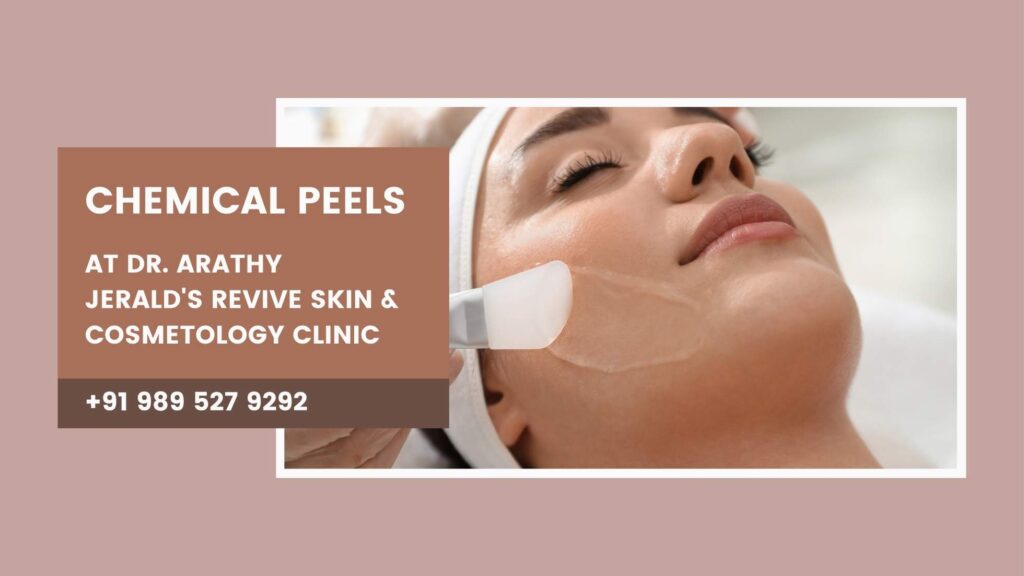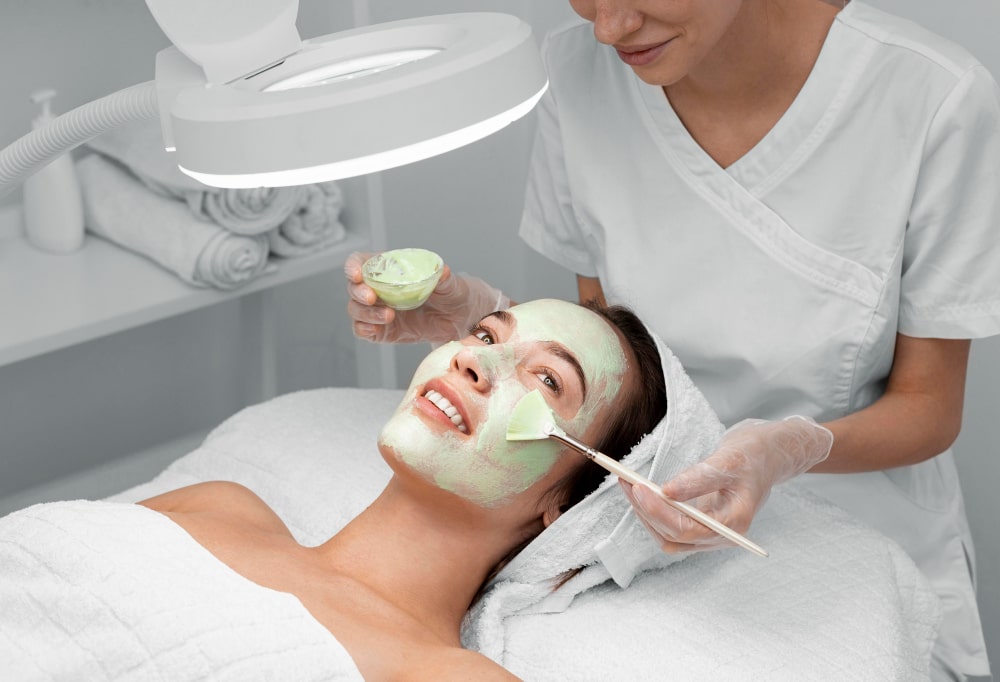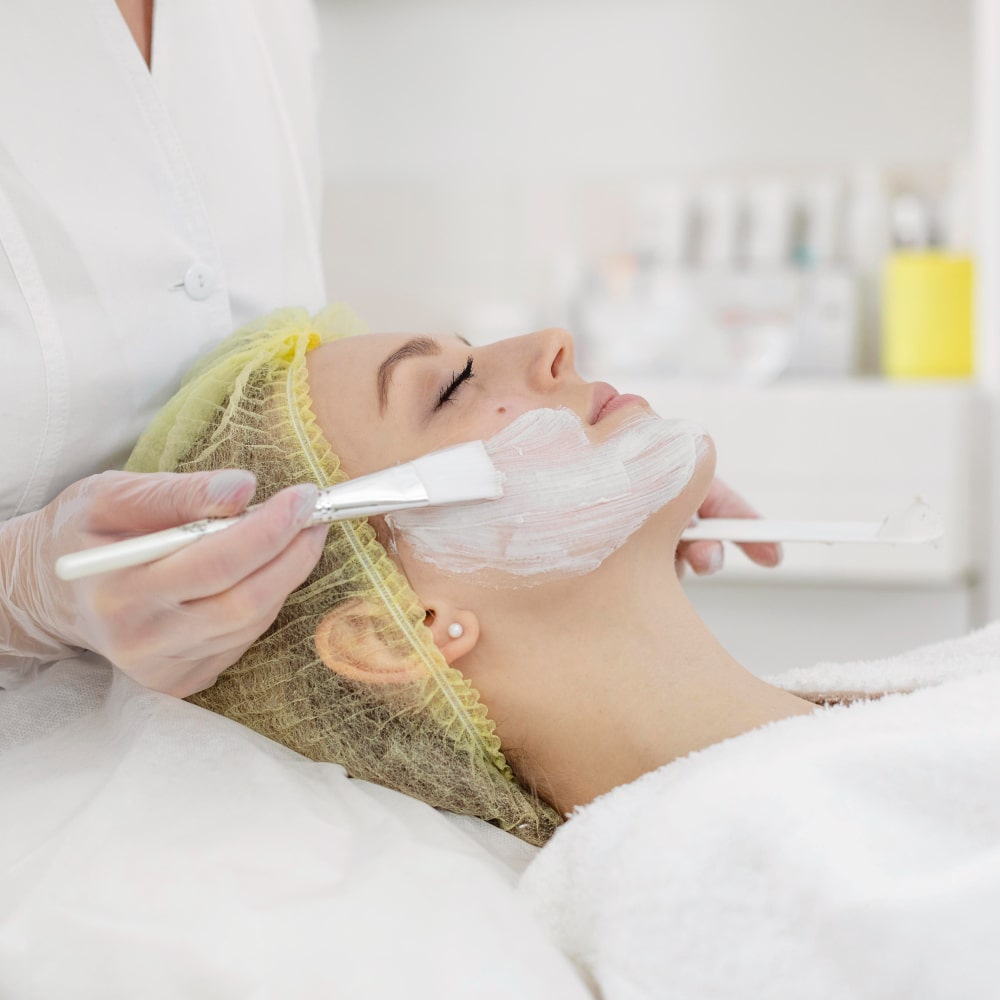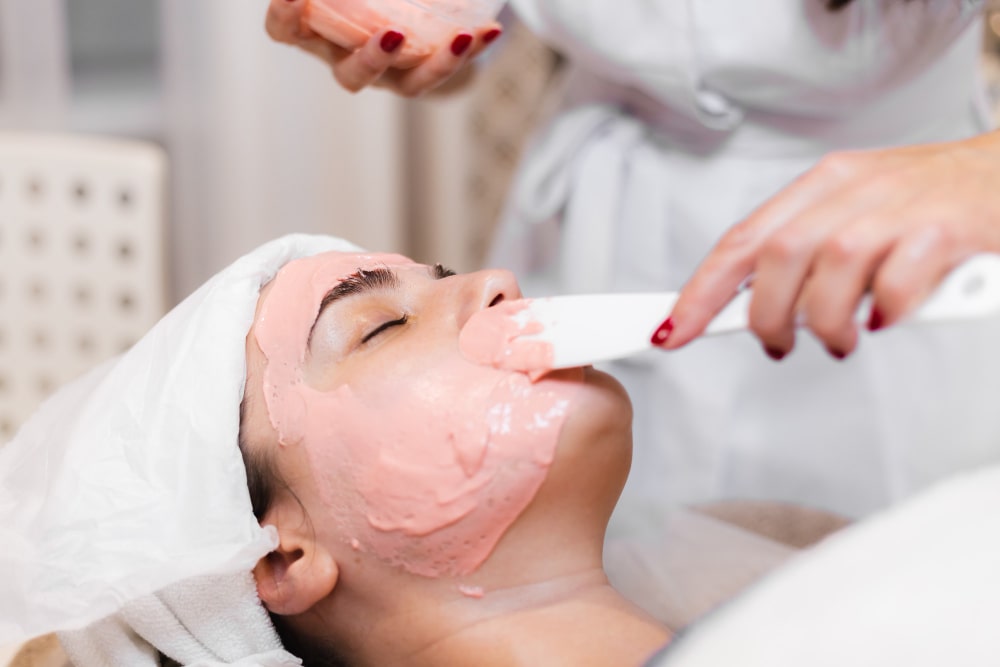
Chemical Peel
At Revive Skin & Cosmetology Clinic, Dr. Arathy Jerald provides chemical peels as a main treatment to refresh and boost the skin’s look. Chemical peels are a gentle cosmetic method used to enhance the feel and color of your skin. This approach can improve the face, neck, or hands to tackle problems like wrinkles thin lines, skin spots, and acne marks.
What is a Chemical Peel?
A chemical peel puts a chemical solution on your skin causing it to shed and peel off over time. The new skin that grows underneath looks smoother, has fewer wrinkles, and appears healthier. This treatment aims to lessen skin damage and boost the overall look of your skin.
Here at Revive, we provide three main types of chemical peels, each targeting different skin issues:

Superficial or Lunchtime Peel: This peel applies mild acids like alpha-hydroxy acid to exfoliate the skin’s outer layer . It suits people with slight discoloration or coarse skin. This quick treatment leaves your skin feeling fresh and radiant.
Medium Peel: This peel uses a stronger solution like glycolic acid or trichloroacetic acid to sink deeper into the skin. It works well to treat age spots fine lines, wrinkles, and moderate skin discoloration. It also has an effect on smoothing rough skin and addressing precancerous growths such as actinic keratosis.
Deep Peel: People with more noticeable wrinkles, age spots, freckles, and shallow scars should consider a deep peel. This treatment uses trichloroacetic acid or phenol to reach the middle layer of skin resulting in a major improvement in how the skin looks. Because of its strength, doctors perform a deep peel once.
What to Expect Before a Chemical Peel
Before you get a chemical peel, Dr. Arathy Jerald will take a close look at your skin to figure out the best plan for you. She needs to understand your skin type, health history, and what you want to achieve to pick the right peel.

Possible Risks of Chemical Peels
Like any skin treatment, chemical peels can have some risks. Dr. Arathy makes sure her patients know about these risks, which include:
Sun exposure and smoking after a peel can cause unwanted effects like infections or scars.
Skin color may change for a short time or forever for people who are pregnant, use birth control, or have had brown patches on their face (melasma) before.
People might get scars or have cold sores come back if they’ve had them in the past.
What Happens After a Chemical Peel
Different peels need different care after treatment:
Superficial Peel: Expect one to seven days to heal. At first, your skin might look red and a bit flaky. Dr. Arathy suggests you put on lotion or cream to keep your skin moist then use sunscreen every day. You can wear makeup the next day.
Medium Peel: It takes about seven to 14 days to heal. Your skin might turn red and swell, and you might see some blisters or peeling. Dr. Arathy will give you step-by-step care instructions. These include soaking your skin putting on ointments, and taking antiviral medicine. Stay out of the sun until you’re healed. You can start wearing makeup again after five to seven days.
Deep Peel: This peel has the most intense effects and takes 14 to 21 days to heal. After the procedure, doctors bandage the skin. Patients need to soak their skin often and then put on ointment. For two weeks after the first healing stage, they should apply thick moisturizers. Doctors also prescribe antiviral drugs. To avoid problems, patients must stay out of the sun for three to six months. They can start using makeup again after 14 days.
Chemical Peels to Treat Acne Scars
If acne scars bother you, you might want to consider a chemical peel. This treatment removes the outer layer of damaged skin allowing new healthy skin to grow. This process can make your scars less noticeable. Dr. Arathy Jerald tailors each treatment to fit the patient’s needs taking into account how deep the scars are and what type of skin the patient has. This approach helps to get the best results.

How Chemical Peels Can Help
Chemical peels are a flexible treatment option that can help in many ways:
Skin that’s smoother and glows more
Less noticeable fine lines and wrinkles
Better skin texture and tone
Treating mild to moderate skin discoloration
Less visible acne scars
Who’s a Good Fit?
Chemical peels work best for people with light skin. People with darker skin can also benefit, but they face a higher chance of uneven skin color.
Risks of Chemical Peels
While they’re usually safe, some risks include:
Changes in skin color: for pregnant women or those taking birth control pills.
Scarring: Not common but can happen.
Cold sore reactivation: People who’ve had cold sores before might get them again after the treatment.
What happens during a chemical peel at Revive Skin & Cosmetology Clinic?
Before undergoing a chemical peel at Revive Skin & Cosmetology Clinic, Dr. Arathy Jerald might recommend a pre-peel skin care plan for 2 to 4 weeks. This preparation helps improve the results and minimizes potential side effects. Dr. Arathy will guide you on whether this step is necessary based on your skin’s condition.
On the day of your chemical peel, the process begins with thoroughly cleansing your skin. If you’re undergoing a deep peel, general anesthesia might be administered to ensure your comfort throughout the procedure. Deep peels are performed in a controlled, surgical environment for safety.
Once your skin is prepped, Dr. Arathy will carefully and evenly apply the chemical peel. She will monitor your skin closely to ensure the peel is removed at the right moment. For deep peels, the skin is treated one section at a time to manage any potential effects on your heart and lungs.
After removing the peel, your skin will be treated according to the type of peel you received. For medium peels, cool compresses and a soothing lotion or cream may be applied. If you’ve undergone a deep peel, your skin may require a surgical dressing for optimal healing.
What should I do after a chemical peel?
At Revive Skin & Cosmetology Clinic, every peel requires some level of at-home care. Here’s what you can expect based on the type of peel:
Superficial Peel (Refreshing or Lunchtime Peel)
- Healing Time: 1 to 7 days. Initially, your skin will be red, followed by possible scaling, which may last 3 to 7 days.
- At-Home Care: Apply lotion or cream until your skin heals, and make sure to use sunscreen daily.
- Makeup: You can typically wear makeup immediately after the peel or by the next day.
- Follow-Up Visit: Not usually required. However, multiple sessions (3 to 5 peels) may be recommended for best results, with intervals of 2 to 5 weeks between treatments.
Medium Peel
- Healing Time: 7 to 14 days. Redness and swelling are common, with swelling peaking in the first 48 hours. Blisters may form, break, and peel off, and your skin will crust before healing.
- At-Home Care: Daily soaks followed by ointment application are necessary. You’ll also need to take antiviral medication for 10 to 14 days and avoid sun exposure entirely until the skin heals. Lotion or cream may also be applied as part of your recovery.
- Makeup: You can use camouflaging makeup after 5 to 7 days.
- Follow-Up Visit: Yes, a follow-up visit will be scheduled to monitor your progress.
Deep Peel
- Healing Time: 14 to 21 days, and the treated area will likely be bandaged.
- At-Home Care: You’ll need to perform 4 to 6 daily soaks while healing, applying ointment after each soak for the first 14 days. Afterward, a thick moisturizer should be applied as directed by Dr. Arathy. You will also take antiviral medication for 10 to 14 days. Sun exposure must be avoided for 3 to 6 months.
- Makeup: You can begin wearing makeup at least 14 days after the procedure.
- Follow-Up Visits: Yes, several follow-up visits will be required, beginning the day after the peel and continuing throughout the first week to ensure proper healing.
Tips for Optimal Results
To ensure you get the best outcome from your chemical peel at Revive Skin & Cosmetology Clinic, follow these tips:
- Use the moisturizer as directed by Dr. Arathy to keep your skin supple and avoid scarring.
- If your skin burns, itches, or swells, contact the clinic immediately. Do not rub or scratch treated skin, as this could lead to infection.
- Avoid tanning beds or any form of indoor tanning, as this can affect the healing process.
- Once your skin has healed, apply sunscreen every day to maintain your results.
Is there downtime after a chemical peel?
If you’ve undergone a medium or deep chemical peel, you’ll experience some downtime. For deep peels, expect to recuperate at home for 2 to 3 weeks.
When will I see results?
Results will become visible once your skin has healed. Healing can take anywhere from one day for a superficial peel to 14 days or more for a deep peel. To achieve your desired outcome from a superficial peel, you may need 3 to 5 sessions.
How long will the results last?
The results of chemical peels are not permanent, as your skin continues to age over time. If you have significant sun damage or precancerous growths, new spots may appear even after the peel.
What are the possible side effects of a chemical peel?
In the hands of an experienced dermatologist like Dr. Arathy, side effects from chemical peels are usually mild. However, some patients may experience:
Persistent redness lasting for months.
Temporary darkening of the skin.
Lighter skin color, particularly with medium and deep peels.
Scarring (rare with experienced dermatologists).
To minimize risks:
Follow Dr. Arathy’s post-treatment instructions carefully.
Avoid sun exposure and tanning beds.
Don’t pick at your skin or apply makeup too early.
When is it safe to have another chemical peel?
Mild and medium peels can be repeated to maintain results. Dr. Arathy will advise on how often you should return for treatments. However, deep peels can only be performed once.
Is chemical peeling safe?
Dr. Arathy Jerald has extensive experience in performing chemical peels with a proven track record of safety. Even those with darker skin tones, such as African American, Asian, or Latino patients, can safely undergo a peel under her care, provided the correct techniques are used.
For more information or to book a consultation, contact Dr. Arathy Jerald at Revive Skin & Cosmetology Clinic, Palakkad, and discover how a chemical peel can rejuvenate your skin.
FAQ
What is a chemical peel, and how does it work?
A chemical peel is a skin-resurfacing treatment where a solution is applied to the skin to exfoliate the outer layers. It helps improve skin texture, reduce blemishes, and enhance skin tone by promoting new skin cell growth.
What skin concerns can a chemical peel address?
Chemical peels can treat a variety of skin concerns, including acne scars, sun damage, wrinkles, uneven skin tone, pigmentation, and rough texture.
How do I know which type of chemical peel is right for me?
Dr. Arathy Jerald will evaluate your skin type and concerns during a consultation at Revive Skin & Cosmetology Clinic. Depending on your skin’s condition, she will recommend the most suitable peel, whether it’s a superficial, medium, or deep peel.
Is there any preparation required before getting a chemical peel?
Yes, some patients may need to follow a pre-peel skincare routine for 2 to 4 weeks, which helps improve the peel’s effectiveness and reduces side effects. Dr. Arathy will guide you on the necessary steps before your procedure.
What should I expect during the chemical peel procedure?
On the day of your peel, your skin will be cleansed, and the chemical solution will be applied evenly. For deeper peels, you may receive general anesthesia. Dr. Arathy will monitor the peel’s progress closely and remove it at the right time.
Is there any downtime after a chemical peel?
Yes, medium and deep peels require downtime. Superficial peels generally don’t require recovery time, while medium peels may require up to 14 days, and deep peels may need 2 to 3 weeks of healing at home.
When will I see the results of my chemical peel?
Results can vary depending on the type of peel. Superficial peels show results within 1 to 7 days, while medium and deep peels may take 14 to 21 days. Multiple sessions may be needed for superficial peels to achieve the desired outcome.
How long will the results of the chemical peel last?
The results are not permanent because your skin continues to age. Regular sun protection and skincare can help prolong the effects. For deeper peels, the results may last longer, but you may still notice new skin issues over time.
Are there any side effects I should be aware of?
Side effects are usually mild when performed by an experienced dermatologist like Dr. Arathy Jerald. You may experience redness, temporary darkening, or lighter skin color. Scarring is rare but can occur if post-treatment instructions are not followed.
How often can I get a chemical peel?
Superficial peels can be repeated every 2 to 5 weeks. Medium peels can be repeated based on Dr. Arathy’s recommendations. However, a deep peel is generally a one-time treatment.